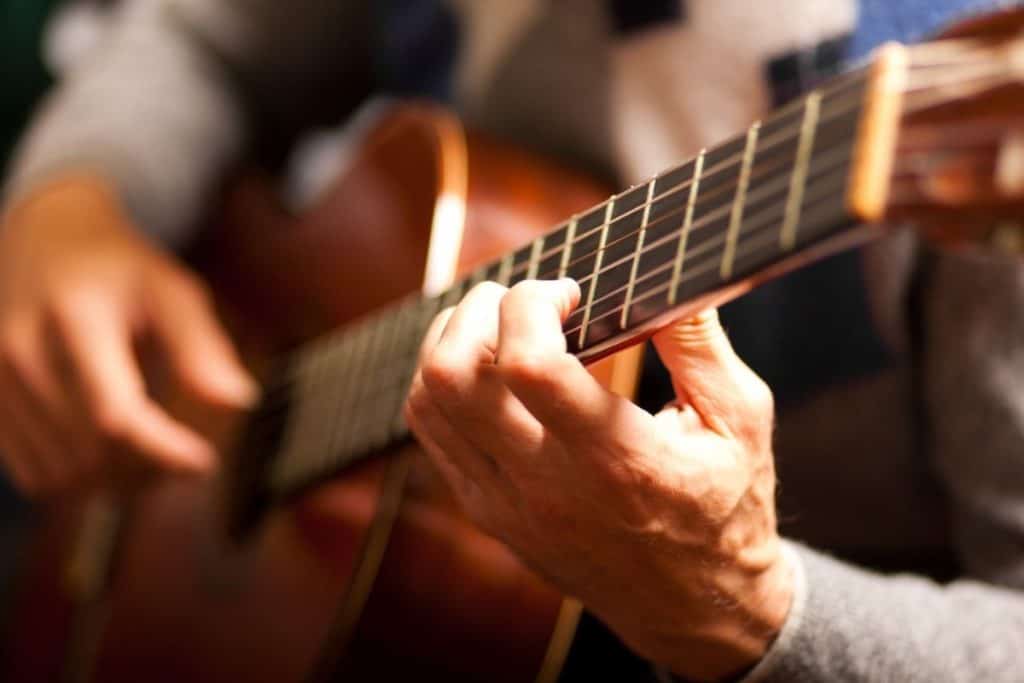If you are just starting to learn about tuning your guitar, you may have started hearing the standard tuning that virtually all guitars use: E, A, D, G, B, and then back to E again.

These make up all the notes your strings can lay, from the lowest up to the highest.
However, if you are learning guitar after already having some experience with a different kind of instrument, then you may be wondering why this is. Or, more specifically, you may be wondering if guitars are fixed to a certain key.
This isn’t a ridiculous question, as many instruments around the world are made to be in a certain key. This isn’t a rare occurrence, either.
It can appear in pretty popular instruments that are widely practiced, such as harmonicas, clarinets, and even trumpets too! That has led many people to wonder if the same thing applies to guitars as well.
Well, wonder no more, because we are going to tell you what, if any, key a guitar is fixed to, as well as some alternate tuning methods that you can use for your guitar if the standard set just isn’t working for you.
What Are Keys?
Firstly, it may be helpful for newcomers to guitar playing to understand what keys are.
After all, if you are in a band session, and someone says to try the song you were just playing again, but in ‘key of C minor’, it would probably help to know exactly what they are talking about!
To put it simply, a key in music, especially in guitar playing, is simply a collection of chords and notes that, when played together, create a specific sound or rhythm. Keys are vital when it comes to song composition.
Most music in countries such as those found in Europe and the Americas tend to come in 12 notes that can be combined and used to create chords, with each note being a semitone higher than the last.
These notes can form groups of three which are known as triads, which can be played together to make chords.
Virtually all guitar keys that you will use in your career as a musician will contain at least 3 chords that are major, 3 chords that are played in minor, and 1 diminished chord.
So, we have established what a key is in music, so we can now discuss what key guitars are fixed to.
Although technically, the question of what key a guitar is fixed to is kind of a misleading question, once you start to take it apart and understand how guitars work.
Are Guitars Fixed To Certain Keys?

Well, for starters, it is worth dispelling the idea that there is one key that your guitar can be tuned to.
The fact is that when it comes to key and tuning, how you eventually learn and decide to play the guitar will have just as much of an effect on what key your guitar is in as the structure of how your guitar is built will.
This is a similar case for most other stringed instruments, including violins, mandolins, and cellos.
However, it is also worth noting that, although personal style dictates how exactly a guitar is played and what key is used, it is also true that all the notes that a guitar can play can be tuned to the Key C Major, and the key of C as a whole, which doesn’t have any flats or sharps that other keys might have.
Signatures Guitar Keys
As we mentioned, the guitar is suitable for playing in most keys.
This has led to the development of what are known as guitar key majors, depending on both the exit build and structure of a guitar, as well as the preferences of the guitar player that is using it and just describes the collection of accidental notes that you’ll find in a pitch, or a note that is not a part of the scale that you are playing.
The key signatures that are used today are the following:
Sharp Majors
- G Major, D Major, A Major, E Major, B Major, F-sharp Major, C-sharp Major
Flat Majors
- F Major, B-flat Major, E-flat Major, A-flat Major, D-flat Major, G-flat Major, C-flat Major
Neither Flat Nor Sharp Major
- C Major
Using A Capo For your Guitar Key Signature
If you have been practicing with guitars for a while, then you have probably heard that a capo may help learn specific keys and chords, and generally help the learning process for you.
A capo is a tool for string instruments that clamps to the neck of the instrument, making the string shorter, and increasing the tension on the string, in the same way, that a guitarist might normally hold strings to a fret with their hand.
This effectively acts as a new point of tension or nut to change the sounds that your guitar strings make.
A capo is a very useful tool for beginners, as it allows them to play different sounding notes and chords, without needing to be able to perform more complex techniques at first. It allows new guitar players to learn at their own pace.
However, it doesn’t necessarily help with learning fretted chords, which a player will need to learn without these tools.
Frequently Asked Questions
How Do I Work Out The Key That I’m Currently Playing?
One of the easiest ways to figure this out is to listen to the first and last chord in the progression that you are playing.
Are There Any Minor Key Signatures?
There are three minor key signatures: Natural, Harmonic, and Melodic, each coming with its chords.
Final Thoughts
As you can see, while the terminology and phrasing around the use of keys in guitars are a little difficult to understand, they do make sense once you understand the basics of what they are made of.
References
Recent Posts
QuickTime is a vital app for many Mac users, and if you’ve recently bought a new microphone, you might wonder how to use it optimally. QuickTime cannot record audio content if it doesn’t have...
Every microphone leaves a unique signature on the quality of its output. If you’re a podcaster trying to melt your way into your audience’s hearts, a muddy, distorted recording won’t cut it....
